Animal hoarding is more severe and complicated than simply having many pets. This complex and severe psychological disorder includes an excessive accumulation of animals--often far beyond the capacity to provide proper care and housing for them.
People who engage in animal hoarding typically have a deep emotional attachment to the animals they collect, but their behavior often leads to neglect and suffering for the animals involved. Animal hoarding frequently includes characteristics such as:

Animal hoarding has several adverse effects on the hoarder's living conditions, making them deteriorate significantly. Some of the factors contributing to the decline in living conditions for hoarders include:
Cleaning up an animal hoarding situation should not be undertaken by individuals not trained and equipped for the task. It requires a coordinated effort involving professionals and organizations with expertise in animal welfare, public health, and biohazard cleanup. Here are some reasons why you should not attempt to clean up an animal hoarding situation on your own:

A professional biohazard cleanup company should be called in to clean animal hoarding messes for several important reasons:
Hiring an unqualified or inexperienced cleanup company to address an animal hoarding mess or any biohazard cleanup situation can lead to various problems and risks, including:

Hiring a qualified cleanup company, especially for sensitive and hazardous situations like animal hoarding cleanup, requires careful consideration and research. Here are the steps and measures you should take to ensure you hire a qualified cleanup company:
At Bio-One, we’re your trusted partner in reclaiming your space from animal hoarding messes. Here's why you should choose us:
What is animal hoarding, and how does it differ from having multiple pets?
Animal hoarding is a complex psychological disorder characterized by keeping an excessive number of animals without the ability to provide adequate care, leading to unsanitary conditions and animal neglect.
What are the signs that a situation has become an animal hoarding case?
Signs include an excessive number of animals, inability to provide proper food, water, and medical care, denial of the animals' suffering, and deteriorating living conditions for both the animals and the hoarder.
Why is cleaning up an animal hoarding site unsafe without professional help?
Such environments often contain biohazards like animal waste, mold, and parasites and may have structural damage, making them unsafe without proper equipment, training, and techniques.
What makes Bio-One qualified to handle animal hoarding cleanup?
Bio-One has trained technicians with expertise in biohazard cleanup, including handling hazardous materials safely and effectively. We adhere to all health and safety regulations.
How does Bio-One approach the emotional aspects of animal hoarding during cleanup?
Our team trains to handle these situations with empathy and sensitivity, respects the hoarder's emotional attachments, and ensures a thorough cleanup.
What is the cleanup process, and how long does it typically take?
The process includes a detailed assessment, waste removal, decontamination, and property restoration. Depending on the severity of the situation, it typically takes two to five days.
How does Bio-One ensure the safety and well-being of the animals involved?
We collaborate with animal welfare organizations and veterinarians to ensure that we provide proper animal care and relocate them to safer environments if necessary.
Are Bio-One's cleanup services discreet and confidential?
Yes, we prioritize your privacy and discretion. Our teams use unmarked vehicles and work with utmost respect for your confidentiality throughout the cleanup process.
What happens to the items and belongings in the hoarding space during cleanup?
We carefully sort items, clean and return salvageable items, and dispose of or donate others to charity according to the client's wishes.
How can I schedule a consultation with Bio-One for an animal hoarding cleanup?
You can contact us 24/7 through our website or phone number. We will arrange a personalized, in-person consultation to assess your situation and provide a comprehensive cleanup plan.
Call Bio-One of East Bay anytime, 24/7, (510) 274-1548 for immediate expert residential or commercial cleaning. Our highly trained teams are equipped to handle all biohazard and trauma scene cleanup complexities and hazards.
Although biohazard and hoarding insurance claims are situations most insurance providers cover, they are typically less common than other types of property claims, such as water damage, theft, or fire.
When these types of claims arise, they can be more complex and time-consuming due to their unique challenges.
You need an experienced biohazard cleanup contractor to help you tackle a biohazard or hoarding claim. You need Bio-One.

Your days include inspecting property damage, investigating claims, and documenting findings.
But add a biohazard claim on top of that? Well, things just got a lot more complicated.
A biohazard claim is problematic—it’s dangerous, urgent, time-consuming, and often requires knowledge and resources most don’t have at their fingertips.
Your challenges include:

A biohazard mess only gets worse with time. Biohazard damage can range from the muck of a backed-up sewer to the shambles of animal hoarding to a horrific crime scene or traumatic suicide.
If not promptly cleaned up, several things can happen over time:
Immediate and professional cleanup will minimize these risks.
A biohazard mess puts your policyholder’s life on hold while waiting for a resolution. Property can’t be used, rented, or sold until it is restored to its former condition. A biohazard mess can also damage a landlord’s reputation and property.
To make matters worse, in some cases, physical damage can be accompanied by intense emotional pain. This pain doesn’t subside until the mess is gone and time has passed.
Biohazard claims can be significantly more demanding than standard damage claims, requiring additional time, expertise, and resources.
These claims often require more extensive documentation and investigation to assess the extent of contamination and determine the appropriate course of action. You must ensure that all aspects of the claim are thoroughly documented, which can be time-consuming.
In addition, you must coordinate with specialized biohazard cleanup companies. This involves obtaining estimates, overseeing the cleanup process, and ensuring the work is completed to the necessary standards.
Due to the nature of these claims, the policyholder and your insurance company may scrutinize you more, requiring you to be very thorough in your assessment and documentation.
Hiring a cleanup company is often outside the scope of your responsibilities; however, they can complicate the situation for you.
For example, unqualified contractors might not effectively remove all hazardous materials, leading to lingering risks and potential secondary damage, such as mold growth or persistent odors.
What’s more, inadequate cleanup may require the work to be redone by qualified professionals , leading to increased costs. Additional costs might also be associated with health care for affected individuals or legal costs from non-compliance issues.
In addition, strict regulations govern the handling and disposal of biohazardous materials. Non-compliance due to inadequate cleanup practices can result in legal ramifications for the policyholder and you, including fines and lawsuits.
In the end, if a cleanup isn’t done correctly the first time, it can lead to delays in resolving the claim.

You face many challenges, and biohazard or hoarding cleanup challenges or mistakes should never be one of them. Bio-One' s mission is to provide effective hazardous cleanup solutions that meet the needs of you and your policyholder.
Their quick, local response and certified expertise make them the ideal choice when seeking peace of mind.

Regular property management services aren’t trained or certified to handle hoarding or biohazard problems such as:
Count on us for efficient, reliable cleanup solutions.
The last thing you or your policyholder wants is to draw attention to the cleanup. They get that. They’re on your side.
They’re the cleanup ninjas. They prioritize discretion in our operations, using unmarked vehicles and adhering to any special requests to maintain privacy and confidentiality. Your reputation and the trust of your policyholders are of the utmost importance to them.
You’re already so busy. You feel pulled in every direction. Biohazardous disasters are inconvenient. They’re not on your calendar. You can’t predict them, but you can prepare for them by keeping their contact information near. They have an office near you.
Find your nearest Bio-One office.
When facing a horrible cleanup, it is crucial to contact Bio-One. They have the expertise, experience, and resources to handle challenging situations safely and efficiently.
Don’t let a biohazard mess overwhelm you; trust the professionals to restore safety and cleanliness to the affected space. Here are tips when calling Bio-One.
Call Bio-One of East Bay anytime, 24/7, (510) 274-1548 for immediate expert residential or commercial cleaning. Our highly trained teams are equipped to handle all biohazard and trauma scene cleanup complexities and hazards.
What types of situations does Bio-One handle?
Bio-One specializes in biohazard and trauma scene cleanups, including unattended deaths, suicides, crime scenes, medical emergencies, hoarding, blood spills, feces/urine cleanup, rodent droppings, sewage backups, mold remediation, and virus/bacteria cleaning.
How quickly can Bio-One respond to an emergency cleanup?
Bio-One offers a 24/7 quick local response. Their trained local technicians can arrive promptly to start the cleanup process as soon as they are contacted.
What makes Bio-One a preferred provider for insurance adjusters dealing with biohazard claims?
Bio-One is experienced in handling the complexities of biohazard and hoarding claims which are often more demanding than standard property claims. They provide efficient and compliant cleanup services that meet safety and discretion standards crucial for insurance claims.
Does Bio-One provide documentation for insurance claims?
Yes, Bio-One ensures thorough documentation and proof of work, which are critical for assessing claims, determining coverage, and ensuring policyholder satisfaction.
What are the risks of delaying a biohazard cleanup?
Delaying cleanup can lead to bacterial growth, spread of infections, bad odors, structural damage, pest infestation, long-term health risks, environmental contamination, and potential legal and compliance issues.
How does Bio-One ensure the safety and discretion required by insurance adjusters?
Bio-One prioritizes discretion and professionalism in their operations, using unmarked vehicles and adhering to any special requests to maintain privacy and confidentiality. They also adhere strictly to industry regulations and protocols to guarantee safety.
What additional challenges do insurance adjusters face with biohazard claims?
Biohazard claims require extensive documentation, specialized knowledge, estimation of cleanup costs, addressing health and safety concerns, and managing emotional and psychological factors associated with the cleanup.
What could happen if an unqualified contractor is hired for biohazard cleanup?
Hiring an unqualified contractor can result in inadequate cleanup, lingering risks, potential secondary damage, increased costs, and legal ramifications due to non-compliance issues.
Why is Bio-One the ideal choice for handling biohazard cleanups?
Bio-One's certified expertise, comprehensive solutions for all types of contaminants, and adherence to strict safety standards make them a reliable choice for insurance adjusters seeking peace of mind during complex cleanups.
How can insurance adjusters prepare for unforeseen biohazard incidents?
Insurance adjusters are encouraged to keep Bio-One's contact information handy and familiarize themselves with their nearest Bio-One location. Knowing the services and response capabilities of Bio-One beforehand can help adjusters manage biohazard incidents more effectively when they arise.

Call Bio-One of East Bay anytime, 24/7, (510) 274-1548 for immediate expert crime scene cleanup. Our highly trained teams are equipped to handle all the complexities and hazards of crime scene cleanup.
A crime scene is not just the location of a crime; it plays a crucial role in forensic science and law enforcement. It provides significant physical evidence that helps to explain what happened, offering insights that are essential for solving crimes and delivering justice.
The evidence found at a crime scene can range widely—from fingerprints that trace back to a suspect to bloodstains that tell a story of conflict to weapons that can be tied to the method of crime. Each piece of evidence serves as a silent witness to the events.
Furthermore, simple things like hair strands, fabric fibers, or bits of soil can give forensic experts important clues to connect suspects to crime scenes or to figure out how events unfolded.
Analyzing a crime scene is a careful and systematic process. It starts with securing the area to keep it clean, followed by thorough documentation, including photos, sketches, and notes. This helps keep the scene unchanged and ensures the evidence remains valid for court cases.
In short, a crime scene is more than just a location; it's a valuable source of forensic evidence. If managed correctly, it can be vital in uncovering the truth about a crime.

The biohazards of a crime scene are biological substances that threaten the health of living organisms, primarily humans.
These can include:
Due to these risks, crime scene investigators and other professionals who work in these environments must wear protective gear, such as gloves, masks, and suits, to minimize the risk of exposure to these biohazards. They also follow strict protocols for collecting, handling, and disposing hazardous materials.

Specialized cleanup teams clean crime scenes rather than law enforcement or crime scene investigators. These teams are trained in dealing with biohazardous materials and have the expertise to clean and cleanareas affected by a crime safely. The process includes several key elements:

Without the proper training, equipment, and cleaning solutions, your cleanup efforts may be inadequate, leaving harmful remnants behind. Considering the infrequent use and high cost of appropriate equipment and chemicals, self-cleaning isn’t cost-effective.
Leave crime scene cleanup to professionals.

Professional crime scene cleanup companies should possess several essential qualifications and attributes to ensure they can safely and effectively handle their work's complex and sensitive nature. These include:
Addressing the aftermath of a crime goes beyond the scope of ordinary cleaning. It requires a specialized, meticulous approach to ensure safety and proper restoration.
Crime scenes are often riddled with biohazards such as bloodborne pathogens, harmful chemicals, and other dangerous substances. This makes professional crime scene cleanup services a convenience and necessity.
These trained professionals have the tools, knowledge, and experience to handle hazardous materials safely and effectively. They adhere to strict health and safety regulations and thoroughly clean and decontaminate the affected areas.
The importance of using specialized equipment and cleaning agents cannot be overstated. They significantly reduce the risk of infection or exposure to harmful substances.
Call Bio-One of East Bay anytime, 24/7, (510) 274-1548 for immediate expert crime scene cleanup. Our highly trained teams are equipped to handle all the complexities and hazards of crime scene cleanup, ensuring your property is safely restored to its pre-incident condition.

For immediate assistance with crime scene cleanup, contact Bio-One of East Bay 24/7 at (510) 274-1548 for discreet, compassionate services. Our local team is proficient and equipped to manage all traumatic situations effectively.
It’s unnerving if your property has become the scene of a crime. It might have been a crime directed at you, or your property was the location of a random crime. Either way, it’s a traumatic event for you and others.
To make matters worse, the crime might have resulted in biohazard contamination. Biohazards are biological materials that pose a threat to human health.
The following types of crimes often result in biohazardous conditions:
In all these scenarios, specialized cleaning and decontamination methods are required to restore the area and safely prevent other health risks.
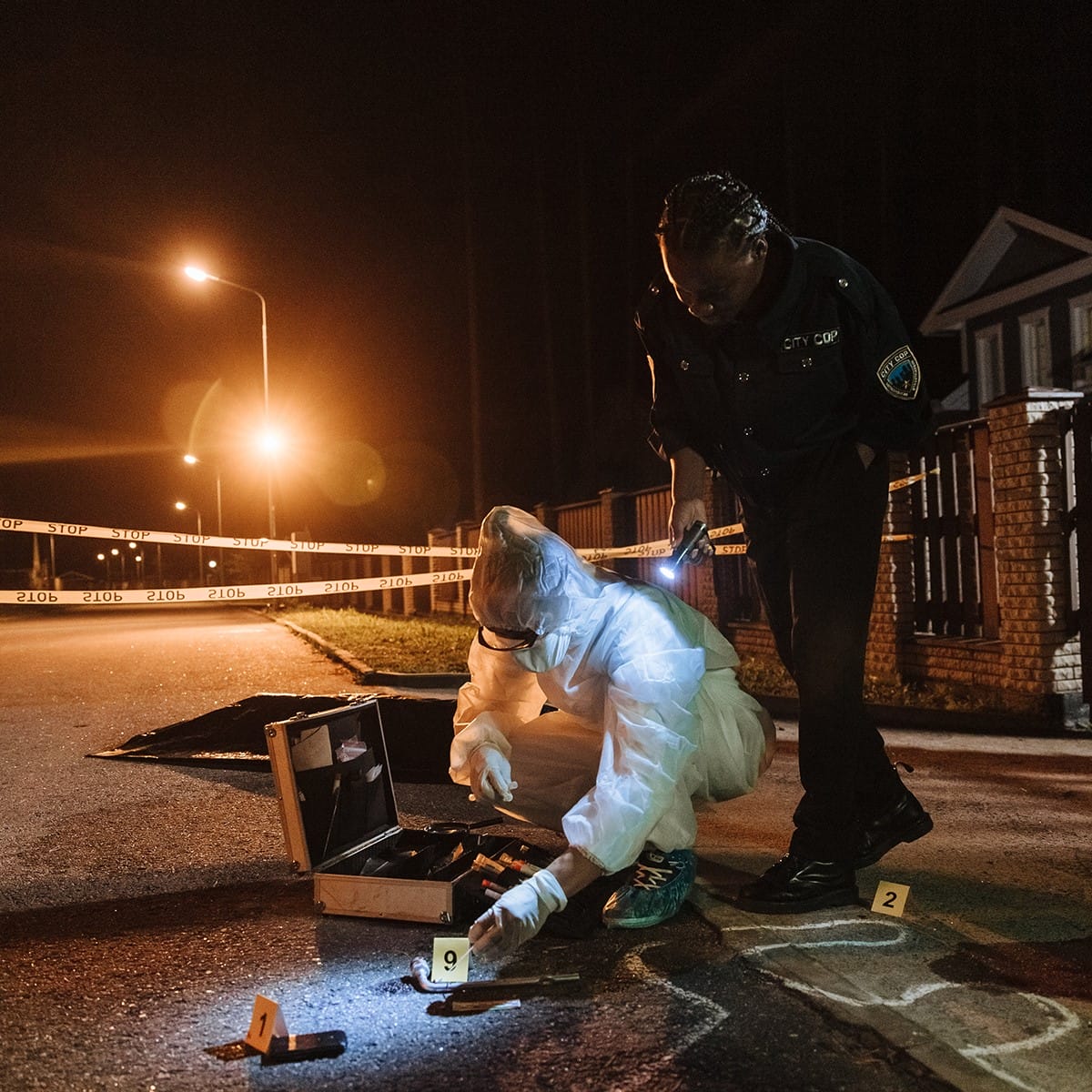
If a crime resulting in a biohazard has occurred on your property, here are the steps you should take:
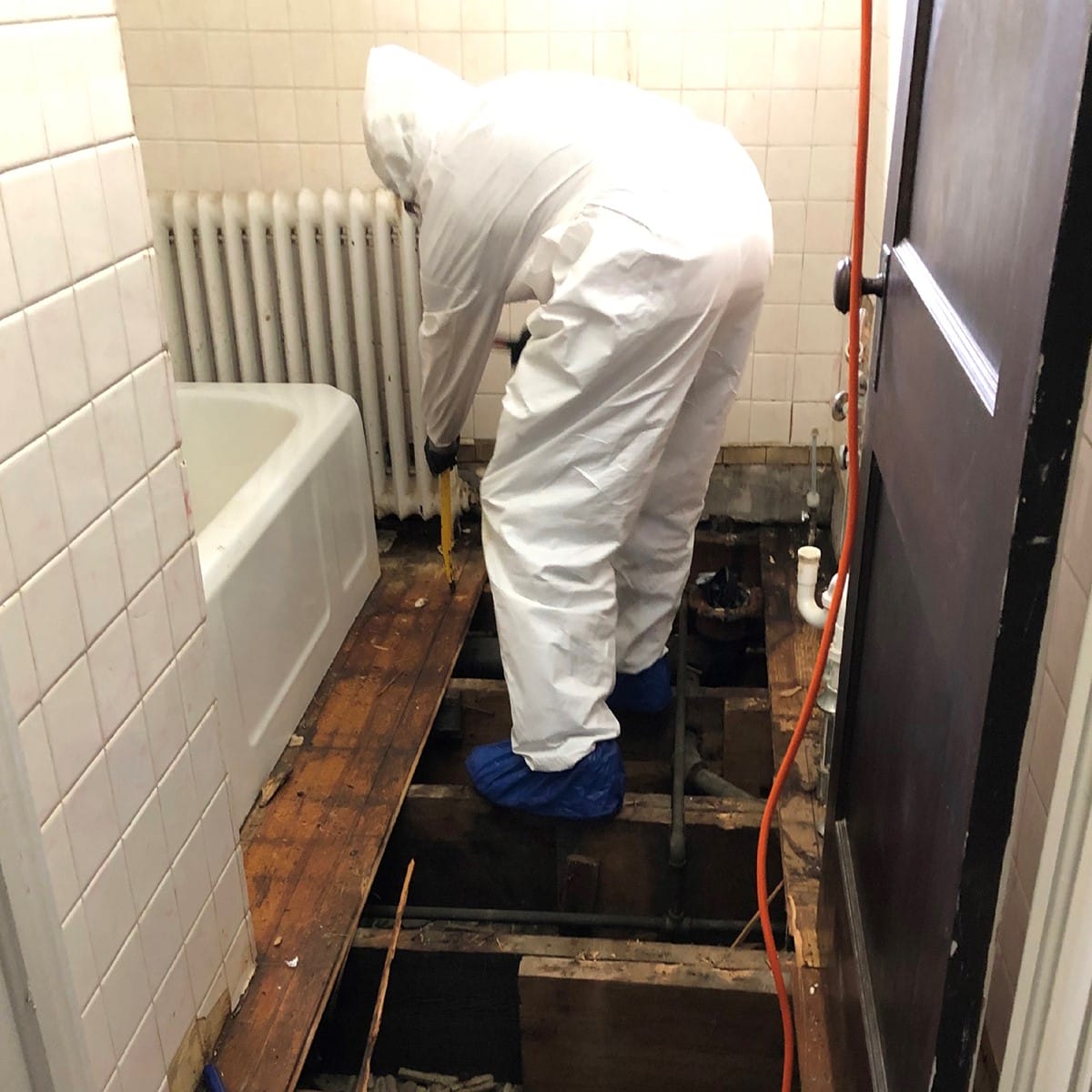
The cleaning of a crime scene is typically handled by specialized crime scene cleanup teams rather than law enforcement or crime scene investigators. These teams are trained in dealing with biohazardous materials and have the expertise to clean and cleanareas affected by a crime safely. The process includes several key elements:
Crime scene cleanup teams operate with a high degree of professionalism and sensitivity. They understand the emotional and traumatic nature of their work, especially in cases involving violent crimes. They also ensure compliance with all relevant health and safety regulations.
In most cases, the property owner is responsible for arranging and paying for these services. However, some insurance policies may cover the costs associated with crime scene cleanup.
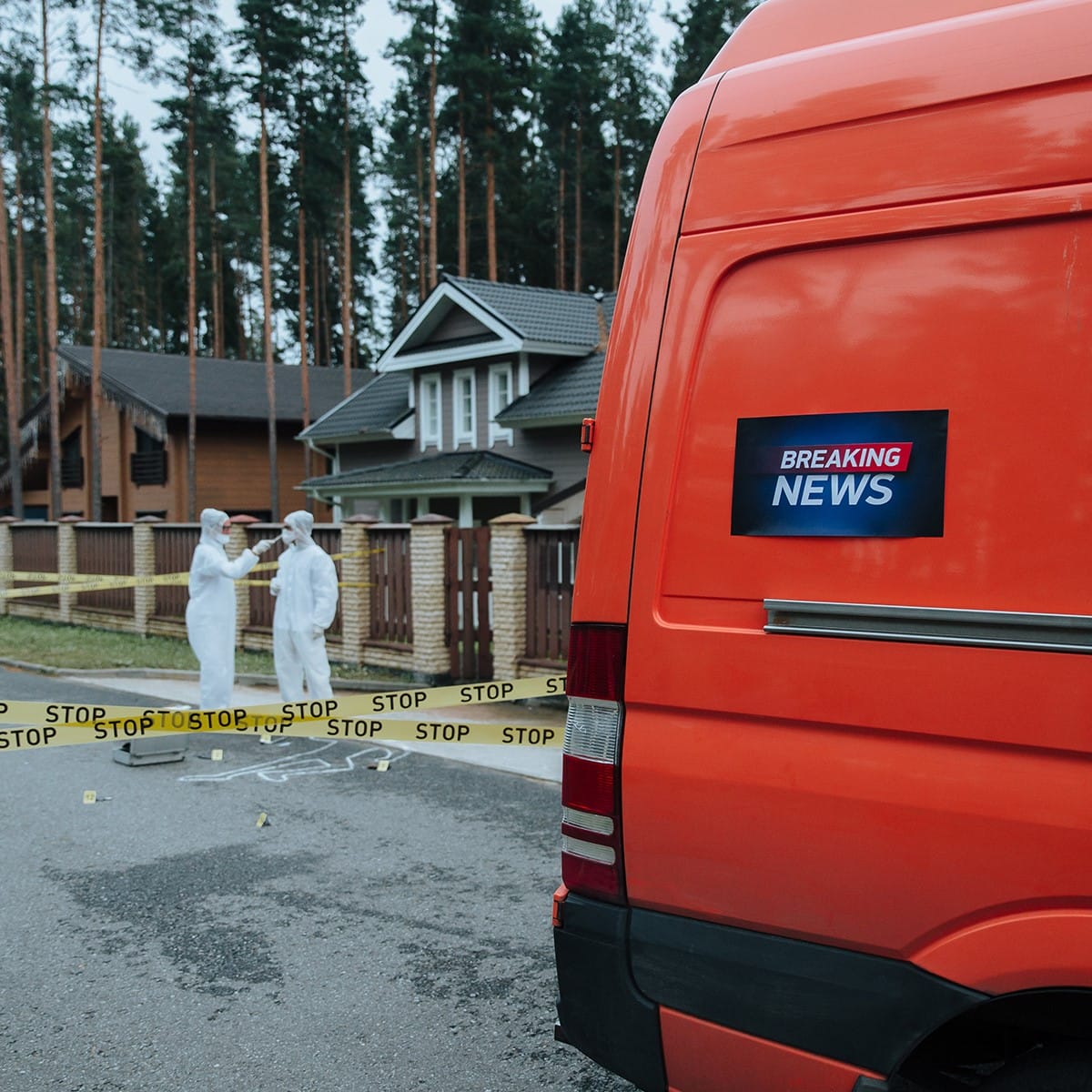
Without the right training, equipment, and cleaning solutions, your cleanup efforts may be inadequate, leaving harmful remnants behind. Considering the infrequent use and high cost of proper equipment and chemicals, self-cleaning isn't cost-effective.
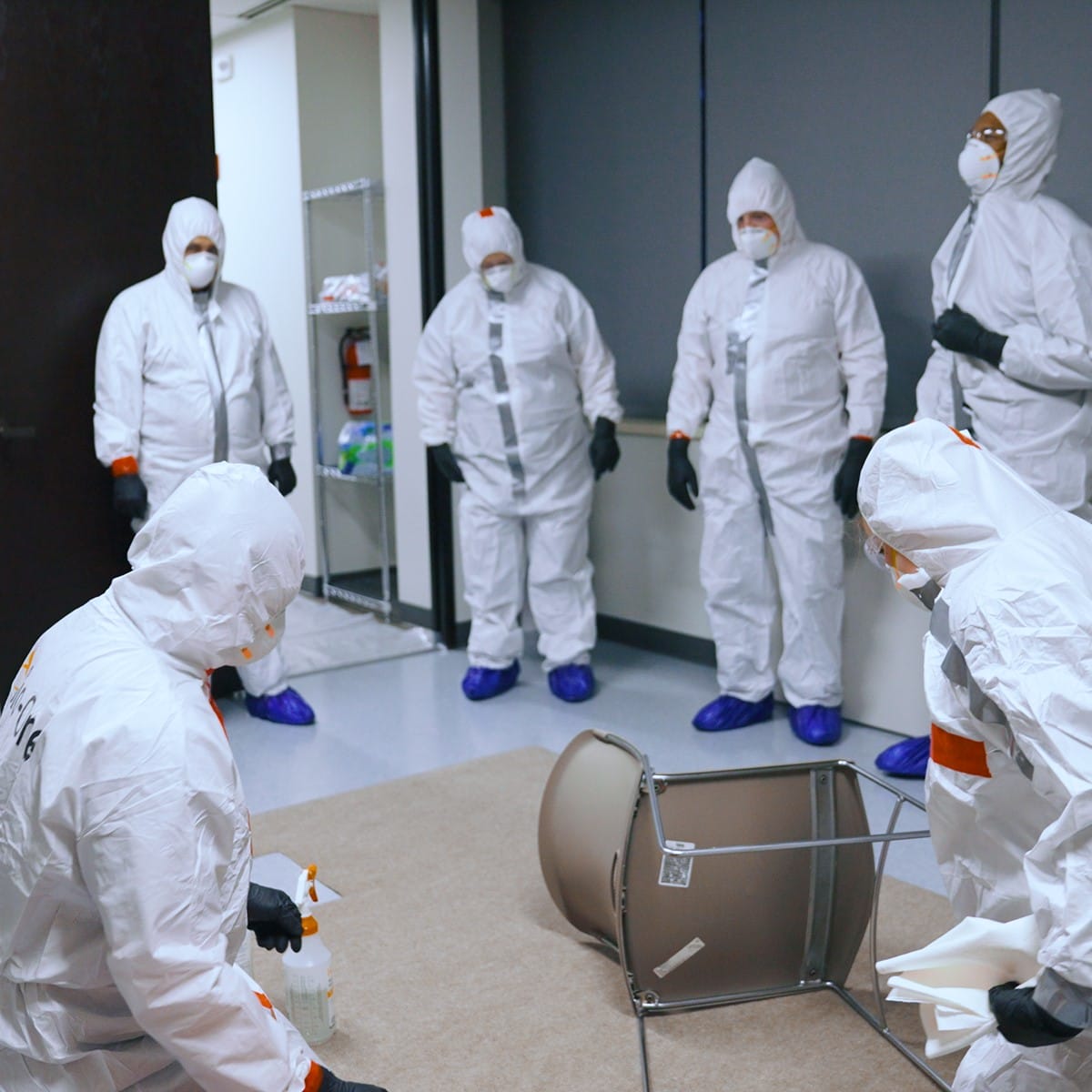
Professional crime scene cleanup companies should possess several essential qualifications and attributes to safely and effectively handle their work's complex and sensitive nature. These include:
Managing a biohazardous crime scene extends beyond just the immediate cleanup. It involves understanding the risks, following the right procedures, and ensuring that the area is returned to a safe and habitable state. This process is about eradicating visible signs of crime and safeguarding the health and well-being of those who may come into contact with the area.
Dealing with a crime scene on your property is a multifaceted challenge. It requires a careful balance of immediate action, adherence to legal procedures, and emotional resilience. Following the steps outlined above, property owners can navigate these difficult waters with a clearer understanding and a sense of preparedness. Remember, the goal is to clean up, heal, and recover from the incident.
For immediate assistance with crime scene cleanup, contact Bio-One of East Bay 24/7 at (510) 274-1548 for discreet, compassionate services. Our local team is proficient and equipped to manage all traumatic situations effectively.
Tips when calling for cleanup.
What is involved in crime scene cleanup?
Crime scene cleanup involves removing and decontaminating biological and hazardous materials from a crime scene. This includes blood, bodily fluids, and tissue cleanup.
How much does crime scene cleanup cost?
The cost of crime scene cleanup varies depending on the extent needed, but it typically ranges from $1,000 to $5,000.
Are your crime scene cleanup services available 24/7?
Yes, we offer 24/7 emergency services to respond to crime scenes promptly.
Does insurance cover crime scene cleanup?
In some cases, homeowner's insurance or crime victim compensation programs may cover the cost of crime scene cleanup. It's advisable to check with your insurance provider.
How long does a typical crime scene cleanup take?
The time required for crime scene cleanup varies based on the severity of the scene. It can range from a few hours to several days.
Are your crime scene cleanup technicians trained and certified?
Our crime scene cleanup technicians undergo specialized training and certification to handle biohazardous materials and follow strict protocols safely.
What types of biohazards are cleaned during crime scene cleanup?
Crime scene cleanup addresses biohazards like blood, bodily fluids, tissue, and other potentially infectious materials.
Can I clean a crime scene myself?
It is strongly discouraged to clean a crime scene yourself due to the risk of biohazard exposure. It's safer to hire professional crime scene cleanup services.
How can I find a reputable crime scene cleanup company?
Look for companies with proper certifications, experience, and positive reviews. You can also ask for referrals from law enforcement or your insurance provider.
What safety measures are taken during crime scene cleanup?
Crime scene cleanup professionals wear personal protective equipment (PPE) and use specialized cleaning agents to ensure safety and thorough decontamination.

For immediate assistance with after-death cleanup, contact Bio-One of East Bay 24/7 at (510) 274-1548 for discreet, compassionate services. Our local professional cleanup team is proficient and equipped to manage traumatic situations effectively.
In the wake of losing a loved one, the world seems to pause, wrapped in a haze of grief and disbelief.
During this challenging and emotional time, the myriad of tasks and arrangements that need to be handled can feel insurmountable, a mountainous journey that one is ill-prepared to embark upon.
Yet, amidst the sorrow and the pain, these tasks beckon for attention, demanding a semblance of normalcy in a world turned upside down.
While specific circumstances surrounding a death can vary widely — from expected passings after long illnesses to sudden losses that leave us reeling — the essence of what needs to be done in the aftermath shares common threads.
This guide's purpose is not to add to the burden of your loss but to offer a gentle roadmap through the maze of practicalities that follow a loved one’s departure. This checklist serves as a starting point, a foundational guide to navigating the initial steps post-loss.
In the following sections, we will delve deeper into each item on the checklist, providing insights, tips, and resources to assist you at every step. Whether arranging the funeral, handling the deceased’s estate, or simply knowing your rights and the support available, this guide aims to lighten your load and offer clarity amidst confusion.
Let’s embark on this journey together, with compassion and understanding, as we explore the critical first steps after the loss of a loved one.

In the immediate aftermath of a loved one’s passing, one of the first considerations may be their wishes regarding organ donation. Giving can save or enhance the lives of many individuals, making it a significant decision.
Here’s how to proceed:
Begin by looking for official documentation indicating the deceased’s organ donation wishes. This is often found on a driver’s license, where a small symbol signifies their consent to be an organ donor. Additionally, an advanced healthcare directive or living will might contain specific instructions regarding organ donation.
If you discover that your loved one is an organ donor, it’s crucial to inform first responders, nurses, or doctors immediately. The timing is critical for organ donation, and healthcare professionals need to know as soon as possible to preserve the organs’ viability.
Organ donation is handled with the utmost respect and care for the donor and their family. It’s helpful to familiarize yourself with the process, including additional consent forms, discussions about which organs or tissues can be donated, and the steps involved in the donation procedure.
While it’s a profoundly personal decision, understanding the impact of organ donation can offer some comfort during this difficult time. Each organ donor can save up to eight lives, while tissue donations can significantly improve the lives of up to 75 people.
Making decisions about organ donation during a time of grief can be overwhelming. Don’t hesitate to seek support from hospital staff, organ donation organizations, or a trusted advisor who can provide information and guidance.
Ultimately, the decision to donate organs should align with the wishes of the deceased. If they had not expressed a decision about organ donation, the responsibility falls to the next of kin to make the decision, keeping in mind what they believe their loved one would have wanted.

When a loved one passes away at home without medical supervision, it’s crucial to know the immediate steps to take. This not only ensures that their death is legally documented but also that you’re guided through the initial stages of managing their passing.
Here’s what to do:
If the death was unexpected, your first step should be to call emergency services (911 in the United States). They will dispatch the necessary personnel to your location.
Clearly explain the situation to the operator, stating that your loved one has passed away at home and there was no medical supervision at the time of death. Provide any details about the deceased’s medical history or circumstances leading to their death that might be relevant.
The operator may provide specific instructions for you to follow. This could include not moving the deceased’s body or attempting to resuscitate if it’s clear the individual has passed away.
In many cases, especially if the death was unexpected, the police and medical personnel will be dispatched to the scene. They are involved in ensuring no foul play and documenting the occurrence officially.
Depending on the jurisdiction and circumstances of the death, a medical examiner or coroner may need to examine the body. If this is necessary, emergency services or the police will coordinate it.
The authorities on the scene will help guide you through the initial documentation needed. This might include a legal pronouncement of death, which is essential for funeral arrangements and the execution of the deceased’s will, and other legal matters.
Don’t hesitate to ask the responding authorities any questions you may have about the process. They can guide you through the immediate next steps, including who to contact next and how to handle the deceased’s body respectfully.
It’s understandably a highly emotional time, but try to remain calm and respectful as the authorities do their job. They are there to help you through this challenging moment and ensure everything is handled correctly and with dignity.

In the immediate aftermath of a loved one’s passing, ensuring the well-being of any dependents — whether children, elderly family members, or pets — is paramount. This adjustment period is critical, and managing their immediate needs with compassion and efficiency can help alleviate the stress during this challenging time.
Here’s how to approach it:
Finding a safe and comforting environment is essential if children are affected by the loss. Reach out to a close family member, friend, or caregiver whom the children know and trust. This person should be capable of providing care for at least 24–48 hours, allowing you time to manage immediate arrangements without added worry.
Depending on the children’s age, explain what has happened in a manner that is sensitive and appropriate for their understanding. Assure that they are being taken care of and that you will be there for them.
Consider these when making arrangements if the deceased had expressed specific wishes regarding who should care for their dependents or if unique family dynamics are at play. It’s important to honor these wishes as much as possible, provided they align with the best interest of the dependents.
Pets also feel the loss and may become anxious or stressed during this time. Arrange for them to stay with a friend, family member, or a pet care service that can give them the attention and care they need. Ensure the caregiver is informed about the pet’s routines, dietary needs, and medical conditions.
Ensure the temporary caregiver has all necessary information for children or pets, including emergency contact numbers, medical records, dietary restrictions, and favorite toys or comfort items. This helps maintain a sense of normalcy and comfort.
Ensure the children and the caregiver can reach you if needed. Open communication is critical to ensuring the dependents feel supported and cared for, even in your absence.
Use this time to start thinking about any long-term arrangements that might need to be made for the dependents’ care and well-being, especially in light of the family’s loss.

The task of informing others about the passing of a loved one is both delicate and necessary. It’s a step that invites support and shared grief but can also be emotionally taxing. Prioritizing who to contact immediately and who can wait is crucial in managing this task without becoming overwhelmed.
Here’s how to approach it:
Begin by contacting those closest to the deceased — spouses, children, siblings, and best friends. These individuals should hear the news from you directly rather than through social media or other indirect means.
For those in the closest circle, phone calls are the most personal and respectful way to convey the news. They allow for an immediate, compassionate exchange and offer an opportunity for mutual support.
If you find the task too overwhelming to manage, it is okay to ask a trusted family member or friend to help notify others. Choose someone close to the deceased who can handle the task with sensitivity.
After informing the immediate circle, list other friends, distant family members, colleagues, and acquaintances to contact. Organizing this list by priority or relation can help streamline the process.
Consider using email, text messages, or social media for the broader circle, especially if you need to notify a large group. A carefully worded message that conveys the news with respect can be appropriate. Remember to ask for discretion in spreading the news until all close family and friends have been personally informed.
People process grief in various ways. Be prepared for a range of emotions from those you notify, from shock and denial to immediate grief. Offer support where you can, and understand if some need space to process the news.
If funeral or memorial service details are available and you feel appropriate, you can share this information with those you notify. Otherwise, let them know that details will follow once arrangements have been made.
Remember notifying others also reminds you of your loss. It’s emotionally draining, so take breaks as needed and lean on others for support during this process.
Securing a legal pronouncement of death is a necessary formal step in the process following a loved one’s passing. This official declaration is the first legal recognition of death and is essential for many subsequent tasks, from arranging the funeral to settling the estate.
Here’s how to navigate this process:
A medical professional is responsible for pronouncing death. If the death occurred in a hospital or hospice, the attending physician would make the pronouncement. In cases where death occurs at home without medical supervision, a qualified professional such as a coroner or medical examiner may need to be involved.
Contact the attending physician, the hospital, or your local medical examiner’s office to obtain a legal pronouncement depending on where and how the death occurred.
Primarily, suppose the death occurred outside of a medical facility. In that case, the body might need to be examined by the medical examiner or coroner to determine the cause of death before a pronouncement can be made.
Once a death has been legally pronounced, you can request official death certificates from the hospital, physician, or your local vital records office or health department. These documents are crucial for many next steps in managing your loved one’s affairs.
Many institutions require an original death certificate to process changes after death (e.g., banks, insurance companies, and government agencies). Estimate how many copies you need and request them upfront to avoid delays. It’s not uncommon to need 10 or more copies.
The process for obtaining a legal pronouncement of death can vary significantly by location, especially regarding who is authorized to make the pronouncement and issue death certificates. Familiarize yourself with local laws and procedures to ensure compliance.
There may be a fee for each copy of the death certificate. While the initial cost might seem minor, it can add up if you require many copies. Plan for this expense in your budget.
Transparent and respectful communication can help streamline interactions with medical or government officials. Remember, these professionals are accustomed to assisting individuals in your situation and can often provide additional guidance.
In the immediate aftermath of losing a loved one, having a support system in place is crucial for both emotional and practical support. Grieving is a deeply personal process, yet it’s important to remember you don’t have to navigate this difficult time alone.
Here’s how to establish and utilize a support system effectively:
Identify family members and friends who can offer you emotional and practical support. Think about those who have been there for you in past times of need and who you feel comfortable relying on now.
Be open with your support network about what you’re going through and how they can help. Let them know whether you need someone to listen, help with funeral arrangements, or manage daily tasks like cooking or childcare.
Many tasks must be completed after a loved one’s death, from funeral arrangements to notifying banks. Divide these tasks among your support network based on each person’s strengths and availability. This approach helps manage the workload and allows everyone to contribute meaningfully.
Grief counselors, therapists, and support groups specialize in helping people navigate the complexities of grief. Don’t hesitate to reach out to these professionals for support. They can offer coping strategies, a compassionate ear, and a safe space to express your feelings.
Many communities have resources for grieving people, including support groups, workshops, and seminars. These resources can provide additional support and connections with others experiencing similar losses.
Sometimes, help comes from unexpected places. If someone offers assistance, consider accepting it. Whether a neighbor offering a meal or a colleague willing to handle some of your responsibilities, these gestures can provide significant relief.
Remember that taking care of yourself is not selfish. Grief can be physically and emotionally exhausting, so eating well, getting enough rest, and engaging in activities that nurture your well-being is crucial.
In moments of deep grief, it might be tempting to isolate yourself. However, staying connected with others, even in small ways, can provide a lifeline during this time. Regular check-ins with friends, family, or a support group can make a difference.
It’s essential to acknowledge the road you’ve embarked upon following the loss of a loved one. The journey through grief is deeply personal, marked by moments of profound sadness, reflection, and, eventually, healing. While the steps outlined in this guide aim to navigate the practical aspects of this journey, remember that the emotional and spiritual journey is equally important.
You may find moments of peace, healing, and hope as you continue your journey. Your loved one’s memory will always be a part of you, shaping your journey in ways seen and unseen. Embrace the journey ahead, with its myriad of emotions, as a testament to the love you shared and the resilience within you.
For immediate assistance with after-death cleanup, contact Bio-One of East Bay 24/7 at (510) 274-1548 for discreet, compassionate services. Our local professional cleanup team is proficient and equipped to manage traumatic situations effectively.
Resources For Those Left Behind After a Suicide Click here for suicide prevention and postvention resources.

There is no timetable on grief, so it’s impossible to say how long it will take for your life to begin to feel normal again.
There may be times when it feels like nothing will ever be right again, but try to remind yourself that this feeling is not forever. You will recover, it just takes time.
It’s hard to be patient with recovery, especially as life keeps moving on around you and pressuring you to continue as normal, but you deserve the time to heal and adjust from this traumatic loss, so allow yourself the time and space to do so.
There are, however, some things you can do to aid in your recovery process and ensure you are on the best possible path toward healing:

It may feel as though there’s nothing a therapist could tell you that you don’t already know, but therapists do a lot more than just talk. A good therapist can:
Professional help won’t cure your grief, but it can help you feel like you have more control over where the grief is taking you.

Because suicide is unfortunately so common, there are many survivors who are going through something very similar to you.
Finding a support group will help you to connect with them. Like therapy, this can give you a forum to work through complicated feelings—but more importantly it can help you feel less alone in what you’re going through.

Support groups are excellent, but it is also a good idea to form a tighter circle of support with those who are grieving the same person you are.
With this group you can share more specific feelings about the situation, as well as find positive ways to honor your loved one together.
Eventually you may find yourself laughing together over happy memories of the person, which is a huge and important step on the road to recovery.
Some people are able to find a greater sense of peace and understanding through personal faith practices.

Whether it’s organized religion or general spiritual practices, finding spiritual meaning in life and death can be hugely beneficial.
However, be aware that some religious belief systems condemn suicide as a sin.
Carefully consider whether these beliefs will aid in your recovery or if another faith would prove more forgiving and uplifting.
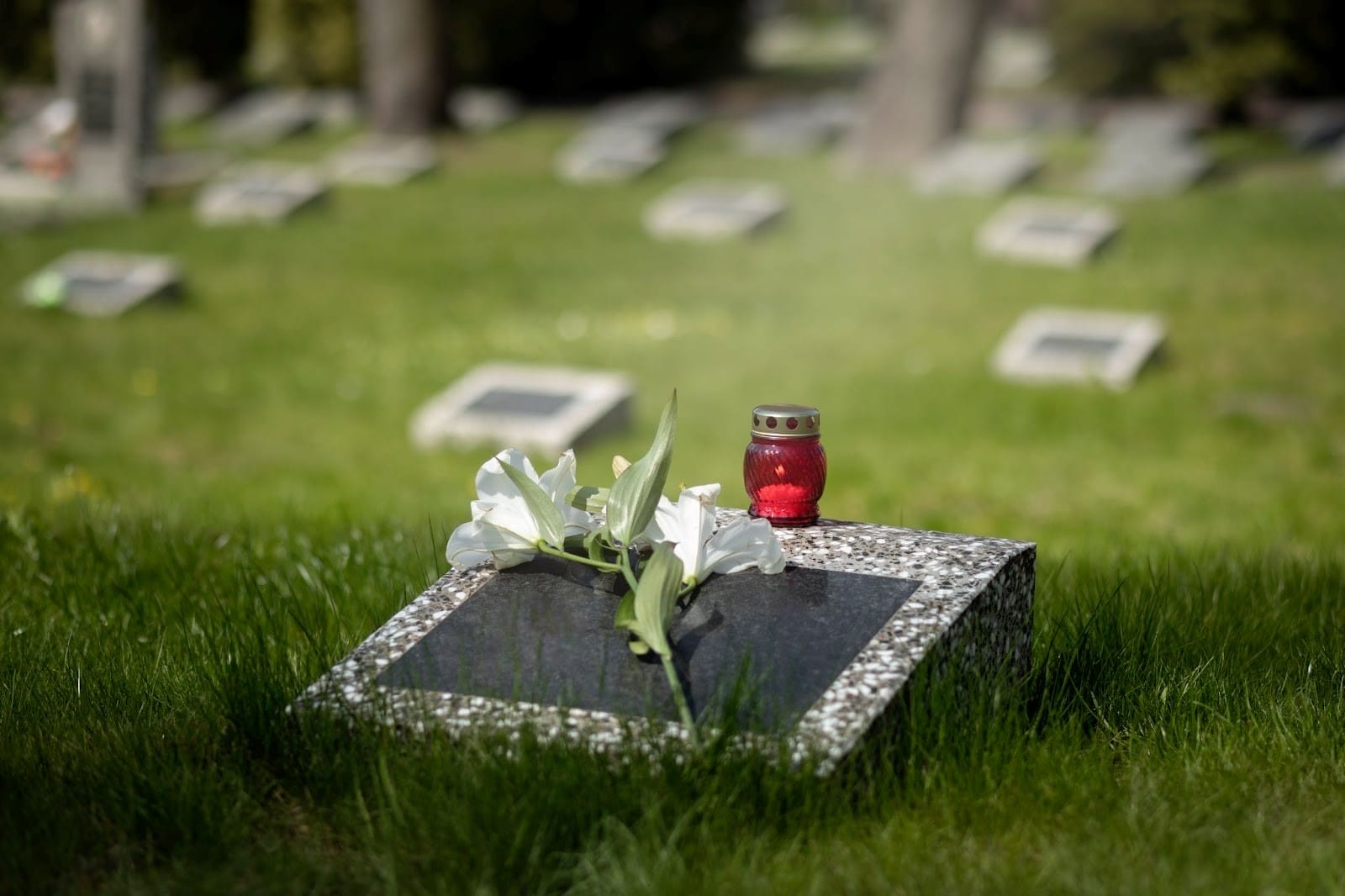
As time goes on, you may find that birthdays, anniversaries, and holidays are especially difficult. During these times, it can be helpful for you and other loved ones to find special ways to honor the person you lost.
These can be small acts, like sharing stories on holidays, or larger things, like celebrating their birthday. Mark the occasion with whatever feels right.
Beginning new traditions is a good way to keep your loved one close to you even as your lives begin to move forward without them.
Above all, community and connection are what will be most helpful in getting you through this time.

Resist the urge to disconnect from others. Do what you can to reach out. Be sure to accept the help of those who are reaching out to you.
There are a lot of other people going through the same tragedy as you, and you can support one another through this difficult journey.
There are also likely people who care about you that aren’t connected to the tragedy who you can lean on.
Even if you aren’t looking for someone to console you, sometimes finding distractions from the pain can be helpful in allowing yourself the space to heal.
In the wake of a suicide, there is often an increase in suicidal thoughts and impulses in loved ones as well. Often, these thoughts are a result of your brain trying to cope with the loss. It can become a genuine risk—particularly among families and friend groups with high rates of mental illness.
To kep everyone safe, have a close community of survivors and encourage everyone to be open with their feelings, especially about suicidal thoughts.
The more your community unites to support and protect each other, the better the chance of preventing this tragedy from happening again.

Your grief may have you feeling a little stuck in time right now—unable to move forward in any meaningful way. As time passes this will begin to ease and you will find yourself beginning to move on.
When the forward motion starts again, it is an instinct for some to try to hang onto their grief out of a sense of duty to the person they lost, or fear that letting go will mean forgetting.
The idea of truly moving on can be scary. If you’re struggling with the transition, volunteering your time to a cause dedicated to preventing suicide and supporting survivors like you can help to ease some of the guilt and fear.
Working to do some good in the name of your lost loved one serves as an excellent bridge to carrying on with your life while still keeping their memory with you.

There may still be bumpy roads ahead. Grief is complicated and can come in spurts and waves, but as you start feeling a little more whole give yourself permission to begin living again.
Little by little, life and joy will return to you, and though the ache may not ever fully go away, things will get better.
Suicide leaves deep wounds in families and communities. The scars will always be there. However, with time and support, you will be able to reclaim happiness for yourself and begin living again.

There is no right answer for how you should be feeling following the suicide of someone close to you.
Grief is complex, and it’s rare that any two people will experience it in the same way.
Just know that whatever you’re feeling is okay.
Some of the most common emotions people report feeling when coping with a loved one’s suicide include:

Especially in the early aftermath, it’s common for people to feel numb, disconnected, and distracted. This shock may last for a long time. You may feel a sense of detachment from reality until you are better able to process what happened.
Depression following a traumatic loss can be almost identical to the symptoms of clinical depression. There may be a lack of energy and motivation, difficulty sleeping, loss of appetite, and overwhelming sadness.
This may ease with time, but in some cases it can mark the onset of an ongoing depressive disorder.

Our brains often try to find someone to blame to protect us from the impact of a loss.
You may be angry at yourself or another loved one for not noticing or acting sooner, or at whatever systems you believe failed the victim.
You may even feel angry at the deceased person for abandoning you or for upending your life with their decision.

If the suicide took place after a long and difficult struggle with mental or chronic physical illness, you may feel a sense of relief that it’s over—particularly if their illness put frequent strain on their relationships.
This is more common than you think, and a lot of people experience this, but you may begin to feel like you’re a uniquely bad person for feeling this way.
This can easily cycle into guilt.
You may begin to convince yourself that you secretly wanted the victim to be gone or feel selfish for your relief over not having to care for them or manage their difficult emotions anymore.
Human relationships are complicated, as is grief, so try to remember that you are not the first person to ever feel this way. Relief does not mean that you’re happy they’re gone, just that you wish something could have been different while they were still around.

Loss can often feel senseless, and so you may fall into a cycle of “if only” to find reason for what happened. Guilt can also result from any other emotion you may find yourself feeling...
Guilt is complex and is perhaps the most common feeling for close loved ones of a suicide victim to experience.

You may experience one of these feelings overwhelmingly throughout your grieving process, or perhaps all of them in some capacity at different times. You may also be feeling something entirely different from any of these.
However your grief is manifesting, there is no wrong way to feel at a time like this. More importantly, you are likely not the only one feeling this way.

People tend to mask when they are feeling something they believe to be inappropriate for the situation, but if you are feeling confusion, guilt, and anger at this tragedy, it’s likely another loved one is struggling with the same feelings.
It may be helpful to talk to others who are experiencing this loss with you. Some may need more space to process their feelings on their own, but others can benefit greatly from sharing their feelings with each other and holding space for whatever emotions are brought to the table.
Finding solidarity in the way that you are grieving can make the process feel a lot less lonely.

Survivors often end up torturing themselves trying to understand why their loved one chose to end their life. It’s very easy to get caught up in replaying the last interactions you had with a person before their suicide to dig out clues that might help make sense of it.
The truth of the matter is that suicide is complicated with no singular explanation for why it happens.
However, a framing that may help it to settle a little better in your mind is this: At the end of all things, your loved one died of an illness.
Most, if not all, victims of suicide were suffering from an acute mental illness. Mental illness causes the chemicals and neurotransmitters in the brain to malfunction in ways they are unable to control.

It was their illness that caused them to feel the compulsion to end their life.
A huge factor of mental illnesses like Depression, Bipolar Disorder, Schizophrenia, and others are that they fundamentally distort a person’s perception.
In their book After Suicide Loss: Coping With Your Grief, Psychologists Bob Baugher and Jack Jordan explain:
“Medical research is also demonstrating that major psychiatric disorders involve changes in the functioning of the brain that can severely alter the thinking, mood, and behavior of someone suffering from the disorder…
The illness produces biological changes in the individual that create emotional and physical pain (depression, inability to take pleasure in things, hopelessness, etc.) which contribute to almost all suicides.”

Often people who suffer with suicidal ideation don’t actually want to die, they simply want the anguish or emptiness that their brain is inflicting on them to stop, and for some, death feels like the only way out.
It may feel like the only thing they can control in a situation that feels fully out of their control.
Mental illness is treatable just as any mental illness is treatable—but some people still succumb to their cancer even with treatment, while others recover and go on to live a full life.

Your loved one did not choose to become ill, and they would not have chosen to end their life had their illness not been pushing them to do so.
You do not need to wonder why their friends and family weren’t enough to keep them around, or why they would want to give up on whatever promising future they may have had. Illness does not have a sense of any of those things—and in the end, their illness is what ended their life.
Understanding this will not make the loss hurt any less, but it may help to reconcile some of the confusion so you can grieve a little more peacefully.

An unfortunate inevitability following a suicide is that you will probably have to tell a lot of people the news about what happened.
By this point you’ve likely already gone through the difficult process of informing immediate family members and friends.
However, it may also fall on you to inform the victim’s employer, teachers, or extended family who may have been out of the direct loop about why your loved one is no longer around. These can be emails if you are not feeling up to calling, and the messages can be direct and brief.

What may be more difficult to handle are conversations with members of your extended community.
In the aftermath of any premature death, people outside of the deceased person’s direct social circle will always want to know what happened. Obituaries often leave out the cause of death, so there will be a lot of questions.
Approach these discussions however you need to.
Many survivors find it helpful to just be straightforward with anyone who asks, but you are not obligated to be. Do not feel as though you are being difficult or unpleasant if you need to tell someone you don’t want to discuss it.

If they were not close to the victim, then all they truly need to know is that the person died.
People will be curious, but they are not owed your limited emotional energy.
Become comfortable with saying no.
If you are struggling with thoughts of suicide or self-harm, you are not alone.
The number of people who experience suicidal ideation in the U.S. every year numbers in the millions. You are not selfish or a bad person for feeling this way.

Be assured that most people who experience moments of intense suicidal feelings are able to recover and live fulfilling lives.
Hold that in mind and keep reading. Let’s take a moment to take stock of your situation:
If you have already tried to self-harm today or are feeling intense suicidal urges, call 911 immediately or have a friend or family member get you to mental health urgent care or an emergency room.

If you have not yet tried to harm yourself but are feeling strong suicidal thoughts or urges to self-harm, please contact a crisis counselor right away:
Fully recovering from your suicidal feelings will require long-term help, but your focus right now should be staying safe through your current suicidal episode.
If you have not yet reached crisis point, here are the steps you should follow to stay safe while you weather the current storm:

If you are experiencing persistent suicidal ideation of any sort, reach out to someone you trust as soon as possible and tell them how you are feeling. Even if you are not likely to hurt yourself right now, having somebody who knows what you are struggling with will make it easier to get help.
You may not feel like there’s much the other person can do, or you may not want to worry them. Try to remember that your perception of your own worth is distorted when you are suicidal.
You are not a burden. You are worthy of help. The first and most important step to keeping yourself safe is to reach out to a friend, family member, or medical professional who can provide you with that help.

Once you have somebody you trust, get their help to remove anything dangerous from your presence. Your trusted person can hold onto any knives, firearms, pills, chemicals, or anything else you could use to harm yourself until you feel safe again.
This is easiest if you have a cabinet or safe where you can lock everything up and turn over the key to your loved one. But any means of keeping these items out of your hands is better than nothing.

Giving yourself a sensory distraction of some sort can help to calm the immediate impulse to self harm. Listen to music, take a walk, lay on the floor (yes, that can be enough), or pet an animal.
If the urge is acute, sensations that are intense but not harmful such as placing ice cubes on your skin can help to keep it at bay. If you just need to divert your attention until the worst of the feelings pass, something mundane and harmless like a movie, game, or craft might help keep your mind occupied until you feel safer.

If you are currently safe but feel your situation may escalate toward self-harm, work on creating a plan in case you enter crisis mode and can’t think clearly.
Save.org has provided this excellent safety plan template where you can write down the steps to follow and people to contact if you start going into crisis. Share this plan with your loved ones, doctors, trusted religious leaders, or anyone else you think might be able to recognize when you are in distress and can take action.

Once the episode has passed and you are in an okay place, you should try to secure some help toward your long-term recovery. It is time to make an appointment with a doctor or mental health professional so they can help you work toward feeling better.
If you are severely depressed, you may be unable to motivate yourself to go through all the necessary steps of scheduling and attending an appointment. It is okay to ask for help with this. You are not a burden. Don’t hesitate to lean on someone in your life to set up your appointment for you, and even to help you get there if necessary.

If financial hardship or other barriers to your seeking mental health treatment are already one of the contributing factors to your suicidal thoughts, do not let these instructions discourage you.
No matter your situation, there are resources for you on both national and local levels. Here are some of the options that may be available to you:

Most states have some level of community mental health services. These can usually be found through the Department of Human Services on your state’s website. Private non-profits can also offer free or sliding scale mental health treatment. A good place to start is your local YMCA or similar community center.

Many churches provide support resources for their congregations. Your church leaders may offer free individual counseling for those who need it. Some congregations may be willing to provide financial assistance to members who need help seeking treatment.
It is also very common for religious communities to sponsor support groups or group therapy. These are often open to the general public, so you do not need to be a member of the congregation or be religious to attend.

There are widely available resources online for people experiencing feelings like yours. Free crisis chat lines are obviously a good place to turn if you are in active distress.
For the process of recovery, many online therapy platforms offer reduced rates for those who are struggling financially. Online support groups can also provide a lot of connection and stability in times of need.
If you are a student, your university almost certainly has a resource center where students can receive mental health assistance. Whether they can provide you counseling on site or help you get in touch with affordable outside treatment, your school can be an incredibly helpful resource.

There are training clinics for every sort of medical practice, from family medicine to mental health, and they often operate at much more affordable rates than other clinics.
The training physicians there are in the final stages of earning their degrees and are overseen by more experienced attending physicians, so the standard of care provided will be exactly the same as anywhere else.
Most people don’t realize how often mental health clinics are willing to work with people who are financially insecure so they can still have access to the treatment they need. Especially if you have been struggling with thoughts of suicide, don’t hesitate to ask a nearby clinic if they can help you work something out.
Once your medical needs are taken care of and you are feeling a little more stable, you can begin to take other small steps to help in your recovery. Small things like reestablishing interest in your hobbies and improving your self-care habits can begin to make a huge difference in how you feel on a daily basis.

Larger steps involve things like finding a broader community of support among others with experiences similar to yours. These can help you progress in your recovery without shame—and provide plenty of support to fall back on in case things ever get difficult again.
Things may seem dire and hopeless right now, but they can and will get better. It is always okay to ask for help and to seek out a new support system if yours has failed you.
Once again, if you are in crisis, don’t hesitate to contact any of these resources:
No matter what you’re feeling right now, you will get through this with time and help. Life will begin to feel kinder and a lot more manageable.
Suicide is an incredibly complicated issue.
There are an overwhelming number of contributing factors, and it affects every demographic regardless of age, race, or social class. Factors affecting certain communities may, however, lead to higher suicidal ideation and behavior within those demographics.

In the United States, suicide is the third leading cause of death among people aged 15-24, and it is estimated to claim the lives of roughly 125 Americans every day. Risk factors are many and varied. They include, but are not limited to:
Statistics can be misleading on which demographics are most at risk of suicide. Among the highest-risk groups overall (teenagers and young adults), females are almost twice as likely to attempt suicide but males make up the majority of actual suicides.

This is due to a handful of different factors, most significantly social stigma preventing many males from seeking help when experiencing distress.
The likelihood of a teenager or young adult attempting suicide also rises significantly if that person is a member of the LGBTQ+ community, especially if they are lacking sufficient family or community support.

The risk can be greatly reduced if a person is surrounded by family or friends who are openly supportive and affirming of their sexuality or gender identity. Even more so if medical and community resources for helping them understand and affirm their identity are widely available.
Overall, in the U.S. there are around 45,000 suicides each year out of 1.1 million yearly suicide attempts. There are many organizations dedicated to keeping that number on a steady decline, including:

Overwhelmingly, the best means of early suicide prevention are:
These methods are not guaranteed, and there is still a very long way to go in managing this complex and serious public health issue, but education and awareness are an important first step.

No matter how overwhelming it may feel, intervention IS effective, and the more we continue to do so, the more lives will be saved. If you or a loved one are currently struggling with thoughts of self-harm, please stop right now and dial 988 on your phone, or text HOME to 741-741 to speak with a crisis counselor.

Suicide is currently an incredibly pressing issue in our world. In the United States, suicide is the third leading cause of death among people aged 15-24, and it is estimated to claim the lives of roughly 125 Americans every day.
With so many suffering in our country, and others suffering from mental illness and suicidal thoughts, it is important for all of us to know how to recognize when someone in our life is at risk of suicide.
However, it is not always readily apparent when someone is struggling with self-harm or planning to take their life. The signs can be subtle and easy to miss. We hope this guide can point out some things to look for so you can recognize when intervention is necessary.
Your awareness may save a life.

There is no singular cause of suicidal ideation or behavior. A variety of situations or life circumstances may be the catalyst for someone wanting to end their life. Risk factors include but are not limited to:

In most of these circumstances, severe mental illness is present—which can make the other issues all the more difficult to handle.
For someone who is suffering from one or more of these factors, it may feel like the only way out is to end their life. They may also feel their struggles make them a burden on others and that it would be better for everyone if they were gone.

There is no definitive way to determine who is most at risk. However, factors affecting certain communities may lead to higher suicidal ideation and behavior within those demographics.
No matter what, having access to support from family and community is a major factor in improving the odds of survival and recovery for a person struggling with suicidal ideation. This makes it crucial for as many people as possible to know how to recognize the signs and intervene.

As previously mentioned, it is not always obvious when someone is struggling. A person who is feeling suicidal may not be very forthcoming, especially in communities where mental illness and suicide are not often discussed in a supportive manner.
Even so, there are some common signs to watch for that may indicate a loved one is in need of support or intervention.
Major warning signs someone may attempt suicide include:
These signs may or may not indicate an imminent suicide attempt, but they should be taken very seriously. Action should be taken as quickly as possible to provide individuals with these indicators of support and to help them find professional help to improve their situation and outlook.
There are likewise a few signs to watch for that may indicate the person is in immediate danger, including:

Any of these three signs should prompt you to immediately reach out to a mental health professional or to call or text the 988 Suicide & Crisis Lifeline for instructions on how you should respond.
If you become aware that the person is in crisis and immediately at risk of harming themselves, call 911 or bring them to an emergency room right away.
Don’t second guess your concern if you see these signs. No reaction is an overreaction when it comes to keeping your loved one safe.
Overwhelmingly, the best means of early suicide prevention are:

If your loved one has reached out to you for help, or if you have noticed any of the warning signs and the situation is not yet an emergency, the next steps are to begin intervention.
Talk to your loved one. If they have not yet confided in you, ask if they have been thinking about suicide, and listen without judgment as they talk about how they are feeling.
After establishing the need for help, involve other trusted members of the person’s family or community to create a support network for them as they navigate this difficult time.
Ultimately, anyone who is struggling with suicidal thoughts or behavior should receive help from a mental health professional.

Their current state of depression or hopelessness may not allow them to seek this help on their own. As part of your intervention, you may need to help them make an appointment with a professional and follow up. This help can ensure they are able to properly begin their road to recovery.
For more information on effective intervention and prevention, you can refer to our guide to effective suicide prevention here.